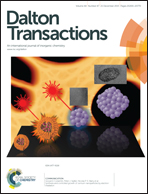User-friendly aerobic reductive alkylation of iridium(iii) porphyrin chloride with potassium hydroxide: scope and mechanism†
Abstract
Alkylation of iridium 5,10,15,20-tetrakistolylporphyrinato carbonyl chloride, Ir(ttp)Cl(CO) (1), with 1°, 2° alkyl halides was achieved to give (ttp)Ir-alkyls in good yields under air and water compatible conditions by utilizing KOH as the cheap reducing agent. The reaction rate followed the order: RCl < RBr < RI (R = alkyl), and suggests an SN2 pathway by [IrI(ttp)]−. Ir(ttp)-adamantyl was obtained under N2 when 1-bromoadamantane was utilized, which could only undergo bromine atom transfer pathway. Mechanistic investigations reveal a substrate dependent pathway of SN2 or halogen atom transfer.


 Please wait while we load your content...
Please wait while we load your content...